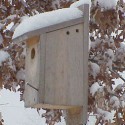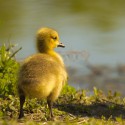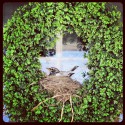 Photo ©
Keith Williams
Photo ©
Keith Williams

Winter-Proofing Your Birdhouse
by Karen Patricio, BirdSleuth student intern
Some birds don’t mind using last spring’s nesting box as this winter’s roost box to keep warm during windy, cold nights. Roost boxes and birdhouses both provide shelter for birds, but roost boxes are not intended for building nests or raising young. They are meant to give cavity-dwelling birds protection from cold temperatures, precipitation, and predators. In his book Birds Asleep, Alexander Skutch describes how birds (particularly those given to nesting in cavities) may crowd together inside a nest box or other hole when temperatures are harsh and food is scarce.
With some modifications, you can repurpose your spring birdhouses by turning them into winter shelters for your backyard birds! Here’s how:
- Before you get started, clean the birdhouse and repair any damage from the nesting season.
- Start winter-proofing your birdhouse by sealing the ventilation and drainage holes to keep warm air trapped inside. You can seal holes with rags, hay, foam weatherstripping, duct tape (on the outside), or any material that will prevent wind from entering.
- Some birdhouses are designed with a movable front panel with an entrance hole at the top. If possible, flip this front panel upside down so that the entrance is on the bottom to reduce heat loss (since hot air rises). If you can’t do that, don’t worry! Remember that any type of shelter, no matter how imperfect, is helpful on a freezing cold night.
- Lastly, place the shelter in a warm and safe location. Choose a spot that has long light exposure–the more sunlight the box sees in the afternoon, the longer it will stay warm in the evening.
Position the house so that the entrance is facing away from prevailing winds to prevent gusts from blowing into the shelter. Also, be sure the placement is safe from predators by placing it high off the ground, or on a baffled pole. Now you have a winter roost box that can help your backyard birds stay warm during those long winter nights!
What about birds that don’t use cavities? They will seek shelter in an evergreen tree, often huddling together on severe nights. Maintain evergreen trees on your property, and consider placing an old Christmas tree outside through the winter (until the needles drop).

Fall Contest Winners
We tallied all of the data submissions received by November 20, and awarded prizes to four lucky NestWatchers. There was even a surprise tie for “most species submitted.” And the winners of the Fall Data Entry Contest are:
- Most nest attempts submitted: Al Gerber, with 337 nests
- Most species monitored: Chrisula Stone and Warren Rofe tied, with 13 species each
- Random drawing: Amy Myers, who submiited a Canada Goose nest
Thanks to everyone who submitted data! If you haven’t finished submitting your data yet, there’s still time. There is no official deadline, but only those submissions received by the end of the year will make it into our 2015 summary report. Log in, submit, and be counted!

Coming to the Small Screen
NestWatch Project Leader Robyn Bailey and Cornell University Museum of Vertebrates bird curator Vanya Rohwer spent time in September with a TV crew to shoot a segment about bird nests for a program called “Awesome Planet” hosted by Philipe Cousteau, Jr. Despite the rain, Robyn showed off local nests to the film crew, while back in the museum, Vanya explored interesting nest specimens from around the world.
The episode, focused on animal architecture, will also showcase engineering feats of bees and beavers. Look for it to air on your local Fox station on December 19 (check local listings for times). You can also watch it on Hulu beginning December 20.

Leave That Wreath!
Putting up a wreath this year? Leave it up all spring, and you could get birds nesting in it next year. Whether the wreath is real or fake doesn’t seem to matter much to the birds. American Robins, House Finches, Dark-eyed Juncos and Carolina Wrens are among the birds most likely to nest in a front door wreath. If a temporary wreath resident would not be welcome on your front door, be sure to relocate the wreath to a less conspicuous location before spring.